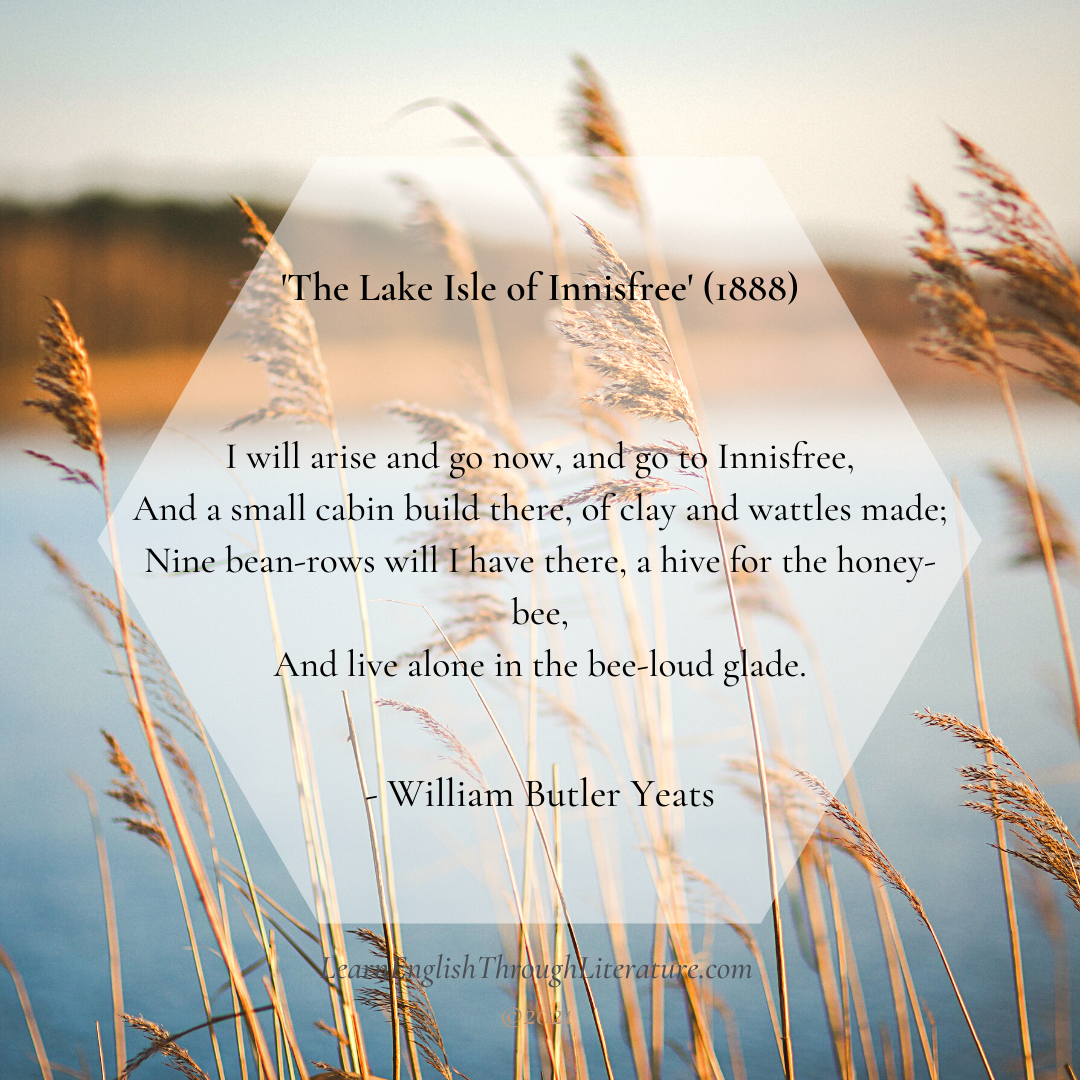📜 I am sharing a poem today that I particularly like: ‘The Lake Isle of Innisfree’ by Irish poet William Butler Yeats (1865-1939).
Yeats’ poem rings a chord in these days when we cannot readily travel but can only dream of places of tranquil beauty. In English, we often speak of such places as ‘oases’ (plural) or an ‘oasis’ (singular): e.g., ‘the cosy, quiet home was an oasis amidst the noisy bustle of the high street’.
Perhaps this following poem will remind you of a special place somewhere that feels like an oasis to you.
I will arise and go now, and go to Innisfree,
And a small cabin build there, of clay and wattles made;
Nine bean-rows will I have there, a hive for the honey-bee,
And live alone in the bee-loud glade.And I shall have some peace there, for peace comes dropping slow,
Dropping from the veils of the morning to where the cricket sings;
There midnight’s all a glimmer, and noon a purple glow,
And evening full of the linnet’s wings.I will arise and go now, for always night and day
I hear lake water lapping with low sounds by the shore;
While I stand on the roadway, or on the pavements grey,
I hear it in the deep heart’s core.
– William Butler Yeats, ‘The Lake Isle of Innisfree’ (1888)
…
Here are some observations that will help you to appreciate Yeats’ writing even more:
🖋️ CONNECTEDNESS THROUGH CONJUNCTIONS AND COMMAS
This poem is very dreamy in its tone, and part of that lulling peacefulness comes from his regular use of the conjunction ‘and’ as well as commas (rather than periods/full stops) to join different observations smoothly, sometimes from one line to the next.
Re-read the first and second stanza, paying attention to where and how he uses it.
His lines mimic or sound like a conversational tone, when we are talking with a flow of words and thoughts …
…
🖋️ ONOMATOPOEIA AND SYNESTHETIC DESCRIPTIVE WORDS
Onomatopoeia simply means words that imitate, suggest, or resemble the sound they are describing. We use it in everyday speech as well as poetry; think of words such as ‘bang’ or ‘sizzle’ or ‘splash’.
‘Lapping’ (to describe the rhythmic sound of the waves on the lake shore) is one onomatopoeiac word that Yeats uses here. Besides that, he uses other words that connect two or more sensory feelings (synesthesia), words like
– ‘bee-loud’ (which sounds decisive and strong when you say it, like the sound of buzzing bees),
– ‘glimmer’ (which describes a light that flickers with a gentle light, while the word’s own sound also imitates its trembling movement)
– ‘glow’ (this word describes the light shining warmly, but it also has a soft, wide sound that suggests the same warmth and expansion)
…
🖋️ SELECTIVE REPETITION
Yeats chose to repeat certain words at regular intervals, words like ‘bee’, ‘peace’, and ‘dropping’. Their effect is to lull (gently quieten and pacify) the readers into a state of feeling some of the peacefulness that Yeats imagines he would feel on his island. Just like a lullaby for a baby includes repetitive sounds, the rhythm that Yeats achieves with repetition also calms and entrances us. We end up being attracted to his idea of the island through this kind of mesmirisation (complete fascination).
Another example of repetition in his poem includes the opening phrase, ‘I will arise and go now’, which is reiterated (repeated) at the beginning of the third stanza. This reminds us of ballads and folk songs with their repetitive choruses, that invite listeners to join in and repeat some words for themselves.
…
While the island of Innisfree is a real place in County Sligo, in the northwest of Ireland, you could say that this poem is an invitation to all readers to dream alongside Yeats about places of serene beauty and restfulness, wherever they may be.




